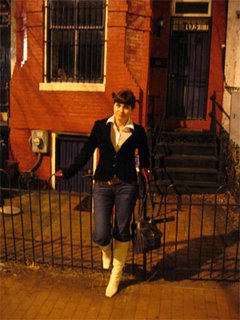
Last night, we had a classic DC experience: We discovered an exquisite DC-style activity, we got lost en route, we found our way, we admired the historic rowhouses surrounding us, we met the DC intelligentsia of photographers, sculptors, and artists; we left the 60s style workshop building quite exhaused but satisfied and well fed with cheese and wine. This is why I love DC - makes me feel good.
A few things about the location of the Capitol Hill Arts Workshop: Capitol Hill is the ground zero of Washington D.C. All streets start being counted from the Capitol, to the east and west, south and north. From First street to 2nd, 3rd, 14th etc. Streets north and south of the Capitol are marked as north and south, east and west respectively, so a street with a SE mark indicates it is to the south and east of the Capitol. This leads to an interesting observation: all numbered streets have doubles, so you should be careful if the street you are headed to is 7th SE or 7th SW. This explains why we got lost last night before we ended up on the quaint, historic Capitol Hill for our workshop.
The workshop was a real studio, the first I have seen; and three experienced photographers shared their vision, philosophy, technique with us, the audience in the 30 something black leather seats. The first photographer talked about his later fascination with the digital technique, but concluded he loves silver prints and the dark room. His major contribution to the art world was his discovery that you can shoot a thousand or more photos of a place of your choice (a bookstore, a historic bar), then make a single giant picture by combining all these individual small pictures. The result is a birds-eye view of the place, a little distorted, detailed and postmodern in look. Essentially, he took digital pictures of the same floor tiles until he covered the whole floor inch by inch, and when combined, voila, you have the whole floor in one! Like a digital jigsaw. While I can understand the unique perspective value, isn't it a little waste of time to repeat the same tecnhique over and over again? Some 80 hours to take 1100 digital pictures of a bookstore floor, combine them, then move on to a bar's floor, do the same - where is the art in this? Anyway, as s mock-photographer, my opinion doesn't really count.
The other photographer was an Italian who spoke English without an accent, and had his 'Bath Tub' series exhibited at the Georgetown university - he was quite sensual and preoccupied with ghost-like nude body parts (ghost effect achieved by leaving shutter open for days!). At some point, I got the feeling he was making fun of us 'Americans'- the unsuspecting audience. I began to get this feeling when he displyed pictures of the belly buttons of various people he knew, and added that he had to take 800 digital pictures of the same belly button to get the right angle! Him being a European, and me knowing how most Europeans feel about American art, I had my reasons to be suspicious. As for the third photographer, well, he took dull, monotonous pictures of rebels in Burma, and the peacekeepers patrolling the green line in Cyprus - they were ordinary pictures of soldiers with rifles. I wish he would take pictures of the local Cypriots, rather than peacekeepers.
My first photography workshop was at Capitol Hill, and I fell in love with the studio. But I think true art takes much more than trying new techniques or a unique perspective, or even having the courage to shoot in war zones. What it takes, I will find out soon.
The prize of the night for me is an artistic picture I took myself, my first artistic picture ever. It is titled "Stairs", and was taken inside the workshop. To me, it symbolizes the ascend to someting new, untried, and fresh:

and above is a picture of me in front of the red brick townhomes I adore.


